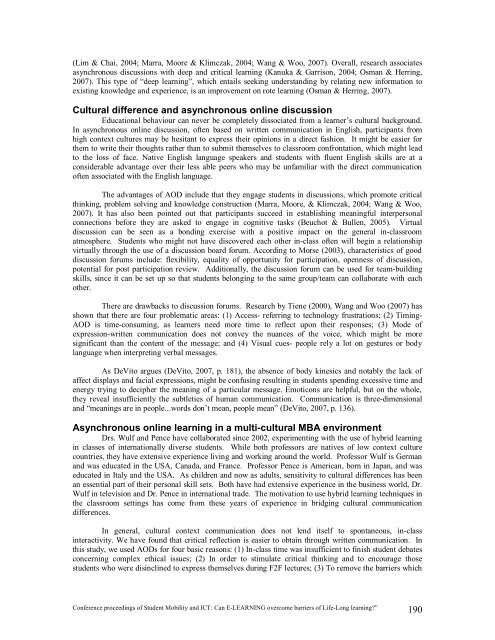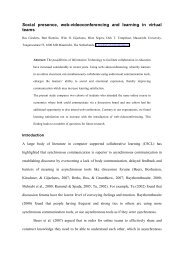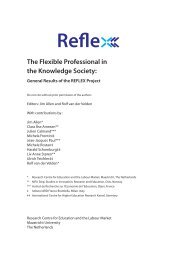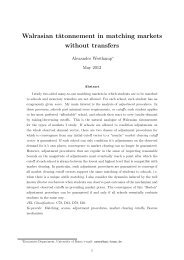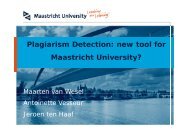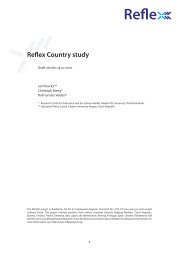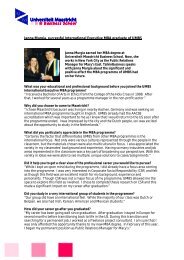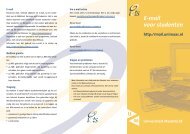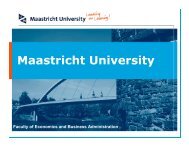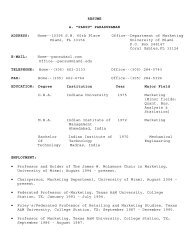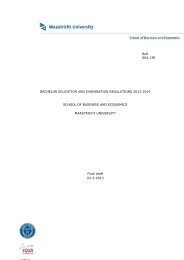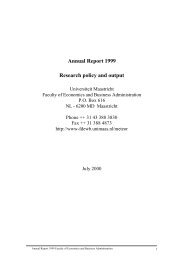proceedings of Student Mobility and ICT: Can E-LEARNING
proceedings of Student Mobility and ICT: Can E-LEARNING
proceedings of Student Mobility and ICT: Can E-LEARNING
Create successful ePaper yourself
Turn your PDF publications into a flip-book with our unique Google optimized e-Paper software.
(Lim & Chai, 2004; Marra, Moore & Klimczak, 2004; Wang & Woo, 2007). Overall, research associates<br />
asynchronous discussions with deep <strong>and</strong> critical learning (Kanuka & Garrison, 2004; Osman & Herring,<br />
2007). This type <strong>of</strong> “deep learning”, which entails seeking underst<strong>and</strong>ing by relating new information to<br />
existing knowledge <strong>and</strong> experience, is an improvement on rote learning (Osman & Herring, 2007).<br />
Cultural difference <strong>and</strong> asynchronous online discussion<br />
Educational behaviour can never be completely dissociated from a learner’s cultural background.<br />
In asynchronous online discussion, <strong>of</strong>ten based on written communication in English, participants from<br />
high context cultures may be hesitant to express their opinions in a direct fashion. It might be easier for<br />
them to write their thoughts rather than to submit themselves to classroom confrontation, which might lead<br />
to the loss <strong>of</strong> face. Native English language speakers <strong>and</strong> students with fluent English skills are at a<br />
considerable advantage over their less able peers who may be unfamiliar with the direct communication<br />
<strong>of</strong>ten associated with the English language.<br />
The advantages <strong>of</strong> AOD include that they engage students in discussions, which promote critical<br />
thinking, problem solving <strong>and</strong> knowledge construction (Marra, Moore, & Klimczak, 2004; Wang & Woo,<br />
2007). It has also been pointed out that participants succeed in establishing meaningful interpersonal<br />
connections before they are asked to engage in cognitive tasks (Beuchot & Bullen, 2005). Virtual<br />
discussion can be seen as a bonding exercise with a positive impact on the general in-classroom<br />
atmosphere. <strong>Student</strong>s who might not have discovered each other in-class <strong>of</strong>ten will begin a relationship<br />
virtually through the use <strong>of</strong> a discussion board forum. According to Morse (2003), characteristics <strong>of</strong> good<br />
discussion forums include: flexibility, equality <strong>of</strong> opportunity for participation, openness <strong>of</strong> discussion,<br />
potential for post participation review. Additionally, the discussion forum can be used for team-building<br />
skills, since it can be set up so that students belonging to the same group/team can collaborate with each<br />
other.<br />
There are drawbacks to discussion forums. Research by Tiene (2000), Wang <strong>and</strong> Woo (2007) has<br />
shown that there are four problematic areas: (1) Access- referring to technology frustrations; (2) Timing-<br />
AOD is time-consuming, as learners need more time to reflect upon their responses; (3) Mode <strong>of</strong><br />
expression-written communication does not convey the nuances <strong>of</strong> the voice, which might be more<br />
significant than the content <strong>of</strong> the message; <strong>and</strong> (4) Visual cues- people rely a lot on gestures or body<br />
language when interpreting verbal messages.<br />
As DeVito argues (DeVito, 2007, p. 181), the absence <strong>of</strong> body kinesics <strong>and</strong> notably the lack <strong>of</strong><br />
affect displays <strong>and</strong> facial expressions, might be confusing resulting in students spending excessive time <strong>and</strong><br />
energy trying to decipher the meaning <strong>of</strong> a particular message. Emoticons are helpful, but on the whole,<br />
they reveal insufficiently the subtleties <strong>of</strong> human communication. Communication is three-dimensional<br />
<strong>and</strong> “meanings are in people...words don’t mean, people mean” (DeVito, 2007, p. 136).<br />
Asynchronous online learning in a multi-cultural MBA environment<br />
Drs. Wulf <strong>and</strong> Pence have collaborated since 2002, experimenting with the use <strong>of</strong> hybrid learning<br />
in classes <strong>of</strong> internationally diverse students. While both pr<strong>of</strong>essors are natives <strong>of</strong> low context culture<br />
countries, they have extensive experience living <strong>and</strong> working around the world. Pr<strong>of</strong>essor Wulf is German<br />
<strong>and</strong> was educated in the USA, <strong>Can</strong>ada, <strong>and</strong> France. Pr<strong>of</strong>essor Pence is American, born in Japan, <strong>and</strong> was<br />
educated in Italy <strong>and</strong> the USA. As children <strong>and</strong> now as adults, sensitivity to cultural differences has been<br />
an essential part <strong>of</strong> their personal skill sets. Both have had extensive experience in the business world, Dr.<br />
Wulf in television <strong>and</strong> Dr. Pence in international trade. The motivation to use hybrid learning techniques in<br />
the classroom settings has come from these years <strong>of</strong> experience in bridging cultural communication<br />
differences.<br />
In general, cultural context communication does not lend itself to spontaneous, in-class<br />
interactivity. We have found that critical reflection is easier to obtain through written communication. In<br />
this study, we used AODs for four basic reasons: (1) In-class time was insufficient to finish student debates<br />
concerning complex ethical issues; (2) In order to stimulate critical thinking <strong>and</strong> to encourage those<br />
students who were disinclined to express themselves during F2F lectures; (3) To remove the barriers which<br />
Conference <strong>proceedings</strong> <strong>of</strong> <strong>Student</strong> <strong>Mobility</strong> <strong>and</strong> <strong>ICT</strong>: <strong>Can</strong> E-<strong>LEARNING</strong> overcome barriers <strong>of</strong> Life-Long learning?” 190


